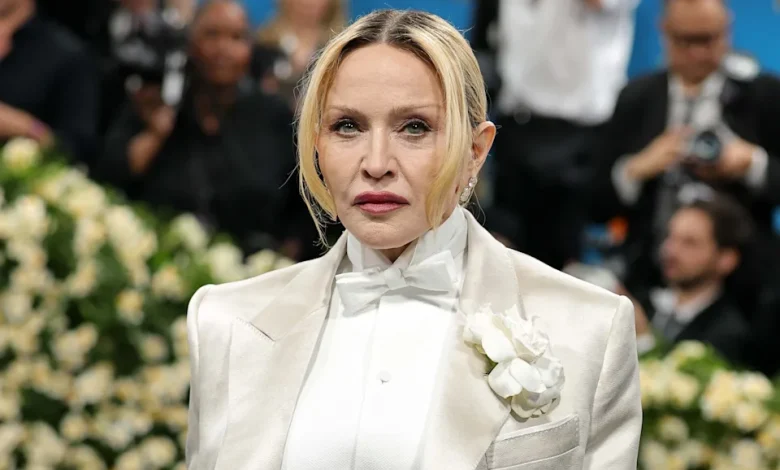Pop Icon Madonna Reveals Secret Battle With Disease That Nearly Killed Her

Madonna, the “Queen of Pop,” has made many comebacks in her long and illustrious career—but in 2025 she revealed a health crisis that nearly ended everything. In a deeply personal conversation, Madonna disclosed that in June 2023 she was struck by a serious bacterial infection that led to sepsis, an induced coma, and a recovery that tested all her physical, mental, and spiritual limits. This article explores what happened, how she survived, and what her journey means not just for fans but for anyone facing life-threatening illness.
The Illness Strikes: Bacterial Infection and Sepsis
In the summer of 2023, Madonna was preparing for her Celebration Tour when she fell gravely ill. She contracted what was initially a bacterial infection. But it rapidly escalated. The infection spiraled into sepsis, a severe systemic reaction that can lead to organ failure, unconsciousness, and death.
Doctors placed her in intensive care. At one point, she was put on a ventilator, and then into an induced coma for 48 hours. She was unconscious for a total of four days.
What Sepsis Means—and Why It’s So Dangerous
To understand the gravity of her condition, you have to understand what sepsis is. Sepsis is the body’s extreme response to infection. When the immune system overreacts, inflammation can spread throughout the body, damaging tissues and organs. According to the Centers for Disease Control and Prevention, sepsis can kill. It leads to organ dysfunction, often requiring prompt medical intervention.
In her case, the sepsis followed a bacterial infection, but such infections can be unpredictable—depending on the bacteria, the speed of diagnosis, the timing and appropriateness of treatment, and the overall health of the individual. In Madonna’s situation, all these variables were severely tested.
The Physical and Psychological Toll
Waking up from a coma was only the beginning of Madonna’s ordeal. When she came out of the ICU, her lungs still needed help—she had been ventilated. She had barely any strength, minimal energy. Just going from her bed to the toilet was a struggle. Even walking across her own backyard was a challenge.
She had hoped to recover quickly, to get back to rehearsals even, but often that was not possible. The fatigue and pain, the uncertainty, the anxiety about whether she would be able to return to her art, to her children, to her life—all of that weighed heavily.
Moments of Clarity: Coma Visions, Mother, Family
During her induced coma, Madonna says she had a vision or spiritual experience. She felt visited by her late mother, who died in 1963. She was asked if she wanted to “come with her,” a symbolic confrontation with mortality, grief, unfinished emotional business. Madonna declined, sensing that she still had things to settle in her life.
That vision prompted reconciliation—especially with her estranged brother, Christopher Ciccone—whom she had been distant from. After his cancer diagnosis, they were able to restore their relationship, and Christopher reached out in his final months. Madonna has described those final moments as “profoundly healing.”
Spiritual and Mental Tools: Radical Acceptance, Faith, Gratitude
A vital part of her survival, Madonna reveals, was spiritual practice and mental health. She credits her study and involvement in Kabbalah, especially the concept of “radical acceptance,” taught by her teacher Eitan Yardeni. Rather than fighting the fear of not knowing when or how the illness would end, she was taught to accept uncertainty. That acceptance, she believes, helped in her healing.
She has also spoken about gratitude—for people who helped, for her children, for the chance she was given. Thanking friends who dragged her to the hospital, medical staff who saved her, and her own spiritual guides.
The Recovery: Triumphs and Struggles
Madonna’s return to health was far from instant. She has been honest about the weakness, the long road back, not knowing when she would feel “herself” again. Activities she once took for granted—walking around her house, going outside into the sun—became benchmarks of progress. Her doctor, Dr. David Agus, encouraged her to get outside, to absorb sunlight for vitamin D and help her body heal.
Her Celebration Tour was postponed, then resumed once she was able. Each performance carried weight—not just musically, but emotionally. She often addressed the audience during shows, sharing glimpses of what she went through: that she had been unconscious, that she almost died. At a concert in Antwerp, she said, “It’s a f***ing miracle that I’m here right now.”
Reflections: Mortality, Empathy, Motherhood
Madonna’s illness forced her to confront her own mortality. She spoke of how lonely hospitals are, the isolation of illness, and her new empathy for her mother—not just in terms of her mother’s death from breast cancer, but for how alone she might have felt in those final days. It changed Madonna’s emotional landscape, giving her deeper compassion.
Her children played a central role in her determination to survive and recover. Seeing them, wanting to be there for them, wanting to be able to parent and perform and create—they were anchors.
What We Can Learn: Hope, Preparedness, Care
From Madonna’s revelation there are several takeaways:
- Early recognition and treatment matter. A bacterial infection may at first seem manageable, but can worsen rapidly. Sepsis must be caught, treated, and monitored aggressively.
- Support systems are vital. Family, friends, spiritual guides, medical professionals—all were crucial in Madonna’s recovery. She publicly thanked her Kabbalah teacher (Shavawn) for helping pull her through, including literally dragging her to the hospital when she collapsed.
- Mental and spiritual health go hand in hand with physical healing. Fear, grief, guilt—those emotional burdens can slow recovery if not addressed. Madonna’s acceptance of uncertainty, her reflections, her spiritual beliefs helped her cope.
- Recovery is not linear. Even after leaving the hospital, her journey involved setbacks. Headaches, fatigue, trouble walking, not feeling like herself. This is common in serious illness recovery.
- Gratitude and perspective can reshape life’s priorities. Madonna’s experiences appear to have shifted some of her priorities toward family, forgiveness, emotional reconciliation, and spiritual meaning. When you brush close to death, some of the things that once seemed urgent adjust in importance.
The Aftermath: Where She Is Now
As of 2025, Madonna is alive and performing. She resumed touring. She has shared her story in interviews and on the On Purpose with Jay Shetty podcast. She speaks openly about the phases of illness and recovery, the moments of fear, the vision in the coma, the reconciliation, and the gratitude.
Though she’s made a “miraculous” recovery in her view, she also acknowledges she’s not quite the same in every respect. She admits that some things—energy, stamina—took a very long time to return. And some scars—emotional, spiritual—may always remain.
Why This Matters
For fans, this revelation is powerful because Madonna has long presented an image of strength, control, invincibility. Pop star, business mogul, boundary-pusher—she has rarely shown vulnerability in public. But her illness reminds us that nobody is immune. Even superstars get sick. Even the strongest have moments when they must surrender to forces beyond their control.
Her story also adds to the broader conversation about illness, recovery, and what it means to heal—not just the body, but the mind and spirit. Issues like sepsis are often under-discussed, even though they affect millions globally every year. The risks, rehabilitation, emotional trauma—all of these are rarely part of the public dialogue until someone in the spotlight brings them forward.
Conclusion
Madonna’s secret battle with disease that nearly killed her is a testament to human frailty—and resilience. She faced a serious bacterial infection, went into sepsis, was placed in an induced coma, and for days lay unconscious. She woke to a very different life, one in which each small act of walking, breathing, standing became a victory. Her journey was aided by family, spiritual belief, mental acceptance, forgiveness. Through it all, she was forced to confront mortality, to soften resentments, to anchor herself in things that matter: love, meaning, faith.
Her recovery is nothing short of miraculous—and in sharing it, she gives others hope. Her story reminds us that even in our darkest hours, strength can be found, support can matter more than we imagine, and survival is possible when hope is never fully lost.



